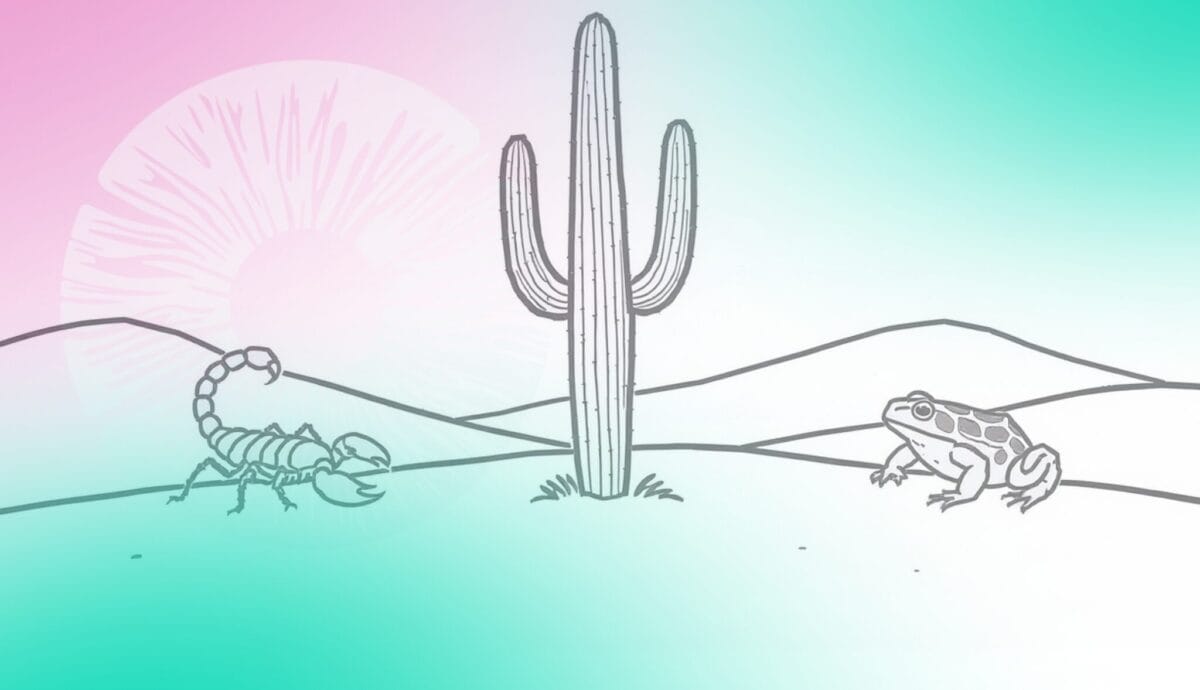The Sonoran Desert toad (Incilius alvarius, formerly Bufo alvarius) produces 5-MeO-DMT in its skin. Demand for that molecule now pressures a fragile animal. Retreats and celebrity stories fuel it. The result is stress on a wild species and its habitat. This piece is pro-facts, pro-ecology, and pro-ethics. Fund population science. Stop pressuring wild toads. Use synthetic instead.
Facts, not myths
These toads spend most of the year underground. They breed when summer rains come. They use temporary pools, canals, and other water sources. Counts swing. In some years people see many toads; in other years almost none. Rain, landscaping, and artificial water drive much of that change. A summer boom is not proof of health.
There is no verified ancient Indigenous practice of smoking toad secretions. The modern practice began in the 1980s after a self-published pamphlet by “Albert Most” (Ken Nelson) explained how to collect and smoke them. A later “revival” story tied to Seri/Comcaac people is false.
The pressures on the toad
Poaching is a problem. Capturing and “milking” toads stresses and displaces them; many die trying to return to their home ranges. But poaching is not the only pressure. Habitat is lost to development and water diversion. Road kill of amphibians here is substantial. Invasive bullfrogs prey on natives. Monsoon timing shifts with climate change. UV-B harms eggs and larvae. Chytrid fungus spreads fast and kills populations.
Two points:
• Sourcing claims are not verifiable in an underground market. Some try to handle animals carefully and release them where found, but illicit supply chains don’t work this way. Buyers cannot verify provenance.
• Good intentions can still cause harm. Moving amphibians or holding them in bins spreads chytrid. Ad-hoc captive holding drifts toward CAFO-like setups: crowded, unsanitary, and cruel. Toad tourism also adds lights, roads, and people to breeding zones, raising mortality.
Cartels have noticed demand. Reports from Mexico describe cartel-linked night harvesting and trafficking of toads and their secretions. When a wildlife product gets hot, professional exploiters move in and out-compete “ethical” claims.
Are toads endangered? We don’t know
We lack a modern, range-wide population study. The IUCN still lists I. alvarius as “Least Concern,” based on a 2004 assessment. California treats the species as extirpated. New Mexico lists it for protection. Arizona restricts collection. NatureServe calls the global rank “Secure,” but state ranks vary. We need data.
Next steps? Commission a government-backed, university-partnered survey across Arizona, New Mexico, Sonora, and Sinaloa. Map key breeding sites. Set baselines. Update status. Then wildlife agencies can use standard tools: habitat protection, permit rules, and, if needed, listings.
Toad vs. tryptamine
Chemically, 5-MeO-DMT is 5-MeO-DMT. Synthetic is the same molecule. Surveys and naturalistic studies show high rates of “mystical-type” experience from both synthetic and toad-sourced material. The animal does not add an extra essence beyond the molecule.
Toad secretions are a mix of 5-MeO-DMT and other alkaloids, including bufotenin, which may increase cardiovascular risk and body load. Ratios vary. Dosing is inconsistent.²⁰ Synthetic avoids extra alkaloids and allows precise dosing.
Cost and scale also favor synthetic. Markets show routes from low-cost materials, even melatonin. There is no ecological or economic case for milking wild toads for a compound we can make.
A fair critique of synthetics—and the answer
Making fine chemicals produces waste. In regulated pharmaceuticals, ~5–50 kg of waste is generated per kilogram of product.²³ Under prohibition, clandestine labs may dump solvents and reagents. Waste is a real problem. That does not justify wildlife extraction. The answer is regulated, above-ground production with enforceable environmental and worker safety standards.
Why blanket bans are not the fix
Parts of the U.S. already restrict or ban collection. California treats the species as gone. Drug-war logic tends to make markets more dangerous. It does not solve root problems. Do this: reduce demand for toad-sourced material, improve lawful access to synthetic, enforce wildlife laws, and fund population science. If the data show a decline, apply the normal endangered-species rules. We need numbers and action.
The market problem
Some claim to harvest “ethically.” Buyers can’t verify. As demand rises for 5, the cheapest supply wins. Predatory actors keep “blood toads” in bins or a chain link fence. They are harvested repeatedly and moved between sites. Disease spreads. Welfare collapses. Buyers cannot easily distinguish between them at the time of purchase.
What you can do
• Choose synthetic, not toad. The experience comes from the molecule.
• Say so, publicly. Inform facilitators and retreat operators that you will not purchase toad-sourced materials. Push dealers to drop it.
• Support field work. The Tucson Herpetological Society’s Sonoran Desert Toad Fund backs monitoring and research.
• Read credible work. Start with Robert A. Villa’s biocultural history and conservation analysis,⁴ and Anny Ortiz’s myth-busting on “ancestral” claims.
• Educate. Informed consent should include ecosystem impacts. Share what you learn.
A personal note
I’ve worked in psychedelics for years. I don’t want a species’ blood on our hands. Our search for healing can cause harm. We should face that. We have a clean option here. Use the synthetic molecule. Leave the toad alone. If these tools connect us to nature, our methods should also honor it.
Editor’s note / Call to action
If this matters to you, donate to the Tucson Herpetological Society’s Sonoran Desert Toad Fund and share this article with peers who may not know the stakes. Choosing synthetic 5-MeO-DMT today helps keep wild toads in the desert tomorrow. Let’s work towards a safe supply for humans and toads.


